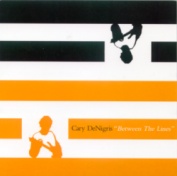Home » Jazz Articles » Album Review » Cary DeNigris: Between the Lines
Cary DeNigris: Between the Lines
Here, joined by Drori Mondlak on drums and Paul Ramsey on electric bass, Cary's finally seized the opportunity to showcase his considerable writing and playing talents for a full 70 minutes.
"Hang On" starts with an odd-time, breathing head featuring challenging unison lines between the leader and the bassist, flowing nicely into a walking 4:4 solo section. DeNigris starts with slashing one note stabs, soon moving into a fluid legato solo, then mixing legato and straight picking to interesting effect . Another featured technique is repeated notes on adjacent strings within the same scale or phrase. A bass solo follows, prompting a question and an observation. The question becomes, "Where did Cary find this guy?", as Ramsey begins to expose himself as the obvious talent-to-be-reckoned-with he becomes by recording's end. The observation is that Cary posesses another chapter in his yet to be written self-help guide, all too often forgotten by the solo-album-making hotshot guitarist which could be entitled "How to Accompany an Instrumental Soloist." A modern electric sound is used in combination with a traditional comping style incorporating ultramodern chord voicings. Thirteen minutes after the starting bell, we indeed have a winner here.
"Going Home" starts off as a pretty jazz waltz with the melody doubled on bass. After a bass solo, the guitar solo transports the entire tune from the public radio jazz playlist to that of a progressive fusion show at a college station. A thick Jeff Beck tone is employed for some sustaining notes giving way to a slippery legato solo into a pretty lead. Then, it' as if Cary says, "Well, listener, we've come this far. Let's journey a bit further out, shall we?" A spaced-out, fuzed-out guitar doubles itself as Cary becomes his own best foil prior to a rocked out ending. Comparing the title to the journey taken by the tune adds interesting insight to Cary's stylistic direction.
"First Dance" is a NYC downtown funk, "blackedelic" vamp that breaks down into a solo over improv'd bass and no-time drums. This goes back into a blues-rock slap 'n'popped vamp over which Cary lays those acidic yet fluffy chords and a double tracked second melody before ending this, the shortest song on the cd, at 6 minutes.
Whoever the inspiration for "Her Eyes" must be, she must start mysteriously and then become very graceful, as does the jazz ballad head on the tune. A slight bit of distortion gives the legato beauty a bit of bite for the seven minutes worth of shredding-oops, that word doesn't belong in here-let's replace it with conversing, that ensues. The sentences get real short before a liquid paragraph takes us back to the head, ending the 12-minute journey.
While "Tail Spin" features a head Charlie Parker might've written if he played a strat and some bop chordal washes that sound almost bowed, "Stop" expounds on a relatively slow blues head with ridiculous fills and beautiful tensions produced by two-note "chords" sounded in unison. "12pm" starts with a rock riff featuring just enough complexity to jazzify it, progressing into a spiraling chord progression. Over a bass vamp for what could be a Primus jam, Cary's solo liquefies all elements of his style as the groove disconnects, giving way to an "ending" that takes a full two minutes of riffing to transform itself into one. "Gray Cliff" is the closer, a creative jazz samba that gains momentum, morphing into a wonderfully RTFish oddtime riff over which Cary cuts utterly, unconditionally loose - which, putting aside any woefully inadequate verbiage about its musical brilliance, is also blatantly indicative of why this solo record had to be made. Hey, I've been listening for quite some time now, and obviously, Cary's never had the forum to take it this far on a recording before. Let's hope the marketplace (uhh, that would be YOU) lets him do it again. Right now, the most efficient way to get the cd is to email Cary at [email protected]. It should be available at www.joyousshout.com by Y2k.
Personnel
Cary DeNigris
guitarAlbum information
Title: Between the Lines | Year Released: 2000 | Record Label: Unknown label
< Previous
Almost Blue: Chet Lives
Next >
Holiday Music '99
Comments
Tags
For the Love of Jazz
 All About Jazz has been a pillar of jazz since 1995, championing it as an art form and, more importantly, supporting the musicians who create it. Our enduring commitment has made "AAJ" one of the most culturally important websites of its kind, read by hundreds of thousands of fans, musicians and industry figures every month.
All About Jazz has been a pillar of jazz since 1995, championing it as an art form and, more importantly, supporting the musicians who create it. Our enduring commitment has made "AAJ" one of the most culturally important websites of its kind, read by hundreds of thousands of fans, musicians and industry figures every month.




















